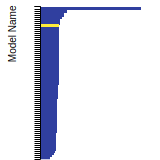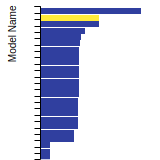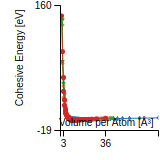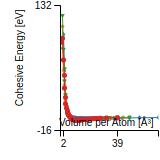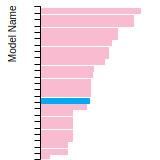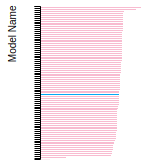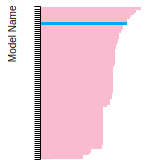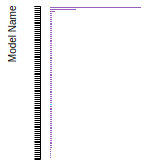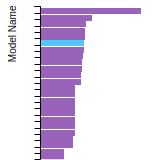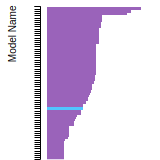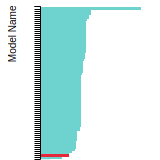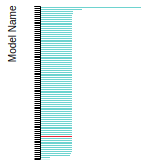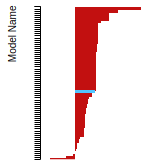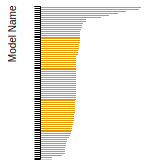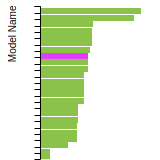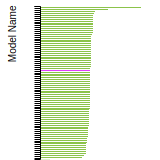 EAM_Dynamo_BelandTammMu_2017_FeNiCr__MO_715003088863_000
EAM_Dynamo_BelandTammMu_2017_FeNiCr__MO_715003088863_000
| Title
A single sentence description.
|
EAM potential (LAMMPS cubic hermite tabulation) for the Fe-Ni-Cr system developed by Beland et al. (2017) v000 |
|---|---|
| Description
A short description of the Model describing its key features including for example: type of model (pair potential, 3-body potential, EAM, etc.), modeled species (Ac, Ag, ..., Zr), intended purpose, origin, and so on.
|
This is a modification of an existing embedded-atom method FeNiCr potential to handle short-range interactions. Density functional theory is used to calculate the energetics of two atoms approaching each other, embedded in the alloy, and to calculate the equation of state of the alloy as it is compressed. The pairwise terms and the embedding terms of the potential are modified in accordance with the ab initio results. |
| Species
The supported atomic species.
| Cr, Fe, Ni |
| Disclaimer
A statement of applicability provided by the contributor, informing users of the intended use of this KIM Item.
|
None |
| Content Origin | https://www.ctcms.nist.gov/potentials/entry/2017--Beland-L-K-Tamm-A-Mu-S-et-al--Fe-Ni-Cr/ |
| Contributor |
I Nikiforov |
| Maintainer |
I Nikiforov |
| Developer |
Laurent K. Béland Artur Tamm Sai Mu German D. Samolyuk Yuri N. Osetskiy Alvo Aabloo Mattias Klintenberg A. Caro Roger E. Stoller |
| Published on KIM | 2022 |
| How to Cite | Click here to download this citation in BibTeX format. |
| Citations
This panel presents information regarding the papers that have cited the interatomic potential (IP) whose page you are on. The OpenKIM machine learning based Deep Citation framework is used to determine whether the citing article actually used the IP in computations (denoted by "USED") or only provides it as a background citation (denoted by "NOT USED"). For more details on Deep Citation and how to work with this panel, click the documentation link at the top of the panel. The word cloud to the right is generated from the abstracts of IP principle source(s) (given below in "How to Cite") and the citing articles that were determined to have used the IP in order to provide users with a quick sense of the types of physical phenomena to which this IP is applied. The bar chart shows the number of articles that cited the IP per year. Each bar is divided into green (articles that USED the IP) and blue (articles that did NOT USE the IP). Users are encouraged to correct Deep Citation errors in determination by clicking the speech icon next to a citing article and providing updated information. This will be integrated into the next Deep Citation learning cycle, which occurs on a regular basis. OpenKIM acknowledges the support of the Allen Institute for AI through the Semantic Scholar project for providing citation information and full text of articles when available, which are used to train the Deep Citation ML algorithm. |
This panel provides information on past usage of this interatomic potential (IP) powered by the OpenKIM Deep Citation framework. The word cloud indicates typical applications of the potential. The bar chart shows citations per year of this IP (bars are divided into articles that used the IP (green) and those that did not (blue)). The complete list of articles that cited this IP is provided below along with the Deep Citation determination on usage. See the Deep Citation documentation for more information. 
32 Citations (23 used)
Help us to determine which of the papers that cite this potential actually used it to perform calculations. If you know, click the .
USED (high confidence) R. Shi et al., “Research on the behaviour and mechanism of void welding based on multiple scales,” High Temperature Materials and Processes. 2023. link Times cited: 1 Abstract: As the core foundation of major national equipment, large fo… read more USED (high confidence) B. Waters, D. S. Karls, I. Nikiforov, R. Elliott, E. Tadmor, and B. Runnels, “Automated determination of grain boundary energy and potential-dependence using the OpenKIM framework,” Computational Materials Science. 2022. link Times cited: 5 USED (high confidence) H. Chen, S. He, J. Chen, F. Chen, S. Zhang, and Y. Zhang, “Molecular dynamics simulation of nanocrack closure mechanism and interface behaviors of polycrystalline austenitic steel,” Frontiers in Materials. 2022. link Times cited: 0 Abstract: Void-type defects in heavy forgings deteriorate their mechan… read more USED (low confidence) C. Dong and W. Jiang, “Molecular dynamics study on the effect of grain size on the plastic deformation of Fe-Cr-Ni alloy nanopolycrystals,” Materials Today Communications. 2023. link Times cited: 0 USED (low confidence) W. Guo, Q.-X. Bai, Y. Dou, T. Wang, and H. Wang, “Effect of stainless-steel substrate grain boundaries on surface graphene morphology and nano-friction behavior,” Applied Surface Science. 2023. link Times cited: 0 USED (low confidence) C. H. Pham, H. Lorenzana, J. Belof, and N. Goldman, “Hugoniot properties of porous stainless steel: Insights from molecular dynamics simulations,” Journal of Applied Physics. 2023. link Times cited: 0 Abstract: We present a systematic study of Hugoniot properties of poro… read more USED (low confidence) Y. Zhao, Y. Li, F. Yang, Z. Xie, X. Wu, and Y. Wang, “Irradiation performance of concentrated solid-solution alloys: insight into defect behaviors,” Journal of Nuclear Materials. 2023. link Times cited: 0 USED (low confidence) C.-L. Chen, S. Galitskiy, A. Mishra, and A. Dongare, “Modeling laser interactions with aluminum and tantalum targets using a hybrid atomistic-continuum model,” Journal of Applied Physics. 2023. link Times cited: 1 Abstract: A hybrid atomistic-continuum method can model the microstruc… read more USED (low confidence) C. Dai, Q. Wang, A. Prudil, W. Li, and L. Walters, “Radiation-induced segregation at grain boundaries of Alloy 800H: experimentally-informed atomistic simulations,” Journal of Nuclear Materials. 2023. link Times cited: 0 USED (low confidence) L. Liu et al., “Displacement cascades database from molecular dynamic simulations in tungsten,” Journal of Nuclear Materials. 2023. link Times cited: 1 USED (low confidence) P. Simonnin, D. Schreiber, B. Uberuaga, and K. Rosso, “Atomic Diffusion, Segregation, and Grain Boundary Migration in Nickel-Based Alloys from Molecular Dynamics Simulations,” SSRN Electronic Journal. 2023. link Times cited: 4 USED (low confidence) K. Peng, H. Huang, H.-F. Xu, Y. Kong, L. Zhu, and Z. Liu, “A molecular dynamics study of laser melting of densely packed stainless steel powders,” International Journal of Mechanical Sciences. 2022. link Times cited: 1 USED (low confidence) P. Zhang, X. Yang, Y. Wang, S. Huang, Y.-Y. Xu, and H. Song, “Effect of aging temperature on ordered structure of Ni-Cr-Al-Fe precision resistance alloy,” Materials Characterization. 2022. link Times cited: 0 USED (low confidence) G. Ge et al., “Effects of order and disorder on the defect evolution of NiFe binary alloys from atomistic simulations,” Nuclear Instruments and Methods in Physics Research Section B: Beam Interactions with Materials and Atoms. 2021. link Times cited: 4 USED (low confidence) S. Zhao, “Influence of temperature and alloying elements on the threshold displacement energies in concentrated Ni–Fe–Cr alloys*,” Chinese Physics B. 2021. link Times cited: 3 USED (low confidence) P. Simonnin, D. Schreiber, and K. Rosso, “Predicting the temperature dependence of self-diffusion behavior in Ni-Cr alloys via molecular dynamics,” Materials today communications. 2021. link Times cited: 6 USED (low confidence) H. Zhu, J. Chen, H. Chen, L. Fang, and K. Sun, “Loading Direction-Dependent Mechanical Properties of Columnar Polycrystal: A Molecular Dynamics Study,” Journal of Materials Engineering and Performance. 2021. link Times cited: 4 USED (low confidence) R. Collette and J. King, “Molecular dynamics simulations of radiation cascade evolution near cellular dislocation structures in additively manufactured stainless steels,” Journal of Nuclear Materials. 2021. link Times cited: 8 USED (low confidence) S. Paul, D. Schwen, M. Short, and K. Momeni, “Effect of Irradiation on Ni-Inconel/Incoloy Heterostructures in Multimetallic Layered Composites,” Journal of Nuclear Materials. 2021. link Times cited: 12 USED (low confidence) S. Wu, H. Cao, D. Wang, L. Jia, and Y. Dou, “Cascades Damage in γ-Iron from Molecular Dynamics Simulations,” Materials Science Forum. 2020. link Times cited: 0 Abstract: The degradation of austenitic stainless steels under irradia… read more USED (low confidence) Y. Wang et al., “Short-range ordering in a commercial Ni-Cr-Al-Fe precision resistance alloy,” Materials & Design. 2019. link Times cited: 16 USED (low confidence) A. Arjhangmehr and S. Feghhi, “A comparative study of primary damage state in Ni and NiCr/NiFe with a model grain boundary structure,” Computational Materials Science. 2018. link Times cited: 5 USED (low confidence) I. C. Njifon and E. Torres, “Cumulative effects of primary radiation damage in alloy 800H: An atomistic simulation study,” Journal of Nuclear Materials. 2023. link Times cited: 0 NOT USED (low confidence) K. Chu et al., “Investigation of chemical short range order strengthening in a model Fe–12Ni–18Cr (at. %) stainless steel alloy: A modeling and experimental study,” Acta Materialia. 2023. link Times cited: 0 NOT USED (low confidence) Y. Lei et al., “An Embedded-Atom Method Potential for studying the properties of Fe-Pb solid-liquid interface,” Journal of Nuclear Materials. 2022. link Times cited: 1 NOT USED (low confidence) B. Zhang, Y. Wang, J. Chen, J. Li, and W. Lai, “Development of an angular-dependent potential for radiation damage study in Fe-Si solutions,” Journal of Nuclear Materials. 2020. link Times cited: 3 NOT USED (low confidence) P. Saidi et al., “Effect of He on the Order-Disorder Transition in Ni_3Al under Irradiation.,” Physical review letters. 2020. link Times cited: 9 Abstract: The order-disorder transition in Ni-Al alloys under irradiat… read more NOT USED (low confidence) J. Drobny and D. Curreli, “F-TRIDYN simulations of tungsten self-sputtering and applications to coupling plasma and material codes,” Computational Materials Science. 2018. link Times cited: 11 NOT USED (high confidence) A. Ghorbani, Y. Luo, P. Saidi, and L. Béland, “Anisotropic diffusion of radiation-induced self-interstitial clusters in HCP zirconium: A molecular dynamics and rate-theory assessment,” Scripta Materialia. 2023. link Times cited: 0 NOT USED (high confidence) A. Tamm, M. Caro, A. Caro, and A. Correa, “Role of electrons in collision cascades in solids. II. Molecular dynamics,” Physical Review B. 2019. link Times cited: 12 NOT USED (high confidence) C. Dai, F. Long, P. Saidi, L. Béland, Z. Yao, and M. Daymond, “Primary damage production in the presence of extended defects and growth of vacancy-type dislocation loops in hcp zirconium,” Physical Review Materials. 2019. link Times cited: 13 Abstract: Production rates in long-term predictive radiation damage ac… read more NOT USED (high confidence) K. Yang, L. Lang, H. Deng, F. Gao, and W. Hu, “Modified analytic embedded atom method potential for chromium,” Modelling and Simulation in Materials Science and Engineering. 2018. link Times cited: 5 Abstract: In the present paper, we have developed a modified analytic … read more |
| Funding |
Funder: Basic Energy Sciences Funder: Carl Tryggers Stiftelse för Vetenskaplig Forskning Award Number: ANR-11-LABX-0053, ANR-11-IDEX- 0001-02 Funder: Agence Nationale de la Recherche Funder: Natural Sciences and Engineering Research Council of Canada Funder: Fonds Québécois de la Recherche sur la Nature et les Technologies Funder: Massachusetts Institute of Technology |
| Short KIM ID
The unique KIM identifier code.
| MO_715003088863_000 |
| Extended KIM ID
The long form of the KIM ID including a human readable prefix (100 characters max), two underscores, and the Short KIM ID. Extended KIM IDs can only contain alpha-numeric characters (letters and digits) and underscores and must begin with a letter.
| EAM_Dynamo_BelandTammMu_2017_FeNiCr__MO_715003088863_000 |
| DOI |
10.25950/3b5d96b4 https://doi.org/10.25950/3b5d96b4 https://commons.datacite.org/doi.org/10.25950/3b5d96b4 |
| KIM Item Type
Specifies whether this is a Portable Model (software implementation of an interatomic model); Portable Model with parameter file (parameter file to be read in by a Model Driver); Model Driver (software implementation of an interatomic model that reads in parameters).
| Portable Model using Model Driver EAM_Dynamo__MD_120291908751_005 |
| Driver | EAM_Dynamo__MD_120291908751_005 |
| KIM API Version | 2.2 |
| Potential Type | eam |
| Grade | Name | Category | Brief Description | Full Results | Aux File(s) |
|---|---|---|---|---|---|
| P | vc-species-supported-as-stated | mandatory | The model supports all species it claims to support; see full description. |
Results | Files |
| P | vc-periodicity-support | mandatory | Periodic boundary conditions are handled correctly; see full description. |
Results | Files |
| P | vc-permutation-symmetry | mandatory | Total energy and forces are unchanged when swapping atoms of the same species; see full description. |
Results | Files |
| B | vc-forces-numerical-derivative | consistency | Forces computed by the model agree with numerical derivatives of the energy; see full description. |
Results | Files |
| F | vc-dimer-continuity-c1 | informational | The energy versus separation relation of a pair of atoms is C1 continuous (i.e. the function and its first derivative are continuous); see full description. |
Results | Files |
| P | vc-objectivity | informational | Total energy is unchanged and forces transform correctly under rigid-body translation and rotation; see full description. |
Results | Files |
| P | vc-inversion-symmetry | informational | Total energy is unchanged and forces change sign when inverting a configuration through the origin; see full description. |
Results | Files |
| N/A | vc-memory-leak | informational | The model code does not have memory leaks (i.e. it releases all allocated memory at the end); see full description. |
Results | Files |
| P | vc-thread-safe | mandatory | The model returns the same energy and forces when computed in serial and when using parallel threads for a set of configurations. Note that this is not a guarantee of thread safety; see full description. |
Results | Files |
| P | vc-unit-conversion | mandatory | The model is able to correctly convert its energy and/or forces to different unit sets; see full description. |
Results | Files |
BCC Lattice Constant
This bar chart plot shows the mono-atomic body-centered cubic (bcc) lattice constant predicted by the current model (shown in the unique color) compared with the predictions for all other models in the OpenKIM Repository that support the species. The vertical bars show the average and standard deviation (one sigma) bounds for all model predictions. Graphs are generated for each species supported by the model.
Cohesive Energy Graph
This graph shows the cohesive energy versus volume-per-atom for the current mode for four mono-atomic cubic phases (body-centered cubic (bcc), face-centered cubic (fcc), simple cubic (sc), and diamond). The curve with the lowest minimum is the ground state of the crystal if stable. (The crystal structure is enforced in these calculations, so the phase may not be stable.) Graphs are generated for each species supported by the model.
Diamond Lattice Constant
This bar chart plot shows the mono-atomic face-centered diamond lattice constant predicted by the current model (shown in the unique color) compared with the predictions for all other models in the OpenKIM Repository that support the species. The vertical bars show the average and standard deviation (one sigma) bounds for all model predictions. Graphs are generated for each species supported by the model.
Dislocation Core Energies
This graph shows the dislocation core energy of a cubic crystal at zero temperature and pressure for a specific set of dislocation core cutoff radii. After obtaining the total energy of the system from conjugate gradient minimizations, non-singular, isotropic and anisotropic elasticity are applied to obtain the dislocation core energy for each of these supercells with different dipole distances. Graphs are generated for each species supported by the model.
(No matching species)FCC Elastic Constants
This bar chart plot shows the mono-atomic face-centered cubic (fcc) elastic constants predicted by the current model (shown in blue) compared with the predictions for all other models in the OpenKIM Repository that support the species. The vertical bars show the average and standard deviation (one sigma) bounds for all model predictions. Graphs are generated for each species supported by the model.
FCC Lattice Constant
This bar chart plot shows the mono-atomic face-centered cubic (fcc) lattice constant predicted by the current model (shown in red) compared with the predictions for all other models in the OpenKIM Repository that support the species. The vertical bars show the average and standard deviation (one sigma) bounds for all model predictions. Graphs are generated for each species supported by the model.
FCC Stacking Fault Energies
This bar chart plot shows the intrinsic and extrinsic stacking fault energies as well as the unstable stacking and unstable twinning energies for face-centered cubic (fcc) predicted by the current model (shown in blue) compared with the predictions for all other models in the OpenKIM Repository that support the species. The vertical bars show the average and standard deviation (one sigma) bounds for all model predictions. Graphs are generated for each species supported by the model.
FCC Surface Energies
This bar chart plot shows the mono-atomic face-centered cubic (fcc) relaxed surface energies predicted by the current model (shown in blue) compared with the predictions for all other models in the OpenKIM Repository that support the species. The vertical bars show the average and standard deviation (one sigma) bounds for all model predictions. Graphs are generated for each species supported by the model.
SC Lattice Constant
This bar chart plot shows the mono-atomic simple cubic (sc) lattice constant predicted by the current model (shown in the unique color) compared with the predictions for all other models in the OpenKIM Repository that support the species. The vertical bars show the average and standard deviation (one sigma) bounds for all model predictions. Graphs are generated for each species supported by the model.
Cubic Crystal Basic Properties Table
Species: CrSpecies: Fe
Species: Ni
Creators:
Contributor: karls
Publication Year: 2019
DOI: https://doi.org/10.25950/64cb38c5
This Test Driver uses LAMMPS to compute the cohesive energy of a given monoatomic cubic lattice (fcc, bcc, sc, or diamond) at a variety of lattice spacings. The lattice spacings range from a_min (=a_min_frac*a_0) to a_max (=a_max_frac*a_0) where a_0, a_min_frac, and a_max_frac are read from stdin (a_0 is typically approximately equal to the equilibrium lattice constant). The precise scaling and number of lattice spacings sampled between a_min and a_0 (a_0 and a_max) is specified by two additional parameters passed from stdin: N_lower and samplespacing_lower (N_upper and samplespacing_upper). Please see README.txt for further details.
Creators:
Contributor: ilia
Publication Year: 2024
DOI: https://doi.org/10.25950/888f9943
Computes the elastic constants for an arbitrary crystal. A robust computational protocol is used, attempting multiple methods and step sizes to achieve an acceptably low error in numerical differentiation and deviation from material symmetry. The crystal structure is specified using the AFLOW prototype designation as part of the Crystal Genome testing framework. In addition, the distance from the obtained elasticity tensor to the nearest isotropic tensor is computed.
| Test | Test Results | Link to Test Results page | Benchmark time
Usertime multiplied by the Whetstone Benchmark. This number can be used (approximately) to compare the performance of different models independently of the architecture on which the test was run.
Measured in Millions of Whetstone Instructions (MWI) |
|---|---|---|---|
| Elastic constants for CrFe in AFLOW crystal prototype A2B_cF24_227_c_b at zero temperature and pressure v000 | view | 105783 | |
| Elastic constants for CrNi in AFLOW crystal prototype A2B_cF24_227_c_b at zero temperature and pressure v000 | view | 111616 | |
| Elastic constants for FeNi in AFLOW crystal prototype A2B_cF24_227_c_b at zero temperature and pressure v000 | view | 347783 |
Creators: Junhao Li and Ellad Tadmor
Contributor: tadmor
Publication Year: 2019
DOI: https://doi.org/10.25950/5853fb8f
Computes the cubic elastic constants for some common crystal types (fcc, bcc, sc, diamond) by calculating the hessian of the energy density with respect to strain. An estimate of the error associated with the numerical differentiation performed is reported.
| Test | Test Results | Link to Test Results page | Benchmark time
Usertime multiplied by the Whetstone Benchmark. This number can be used (approximately) to compare the performance of different models independently of the architecture on which the test was run.
Measured in Millions of Whetstone Instructions (MWI) |
|---|---|---|---|
| Elastic constants for bcc Cr at zero temperature v006 | view | 17943 | |
| Elastic constants for bcc Ni at zero temperature v006 | view | 18947 | |
| Elastic constants for diamond Fe at zero temperature v001 | view | 16847 | |
| Elastic constants for fcc Cr at zero temperature v006 | view | 9691 | |
| Elastic constants for fcc Fe at zero temperature v006 | view | 18191 | |
| Elastic constants for fcc Ni at zero temperature v006 | view | 9803 | |
| Elastic constants for sc Cr at zero temperature v006 | view | 20835 | |
| Elastic constants for sc Fe at zero temperature v006 | view | 9542 | |
| Elastic constants for sc Ni at zero temperature v006 | view | 10287 |
Creators:
Contributor: ilia
Publication Year: 2024
DOI: https://doi.org/10.25950/2f2c4ad3
Computes the equilibrium crystal structure and energy for an arbitrary crystal at zero temperature and applied stress by performing symmetry-constrained relaxation. The crystal structure is specified using the AFLOW prototype designation. Multiple sets of free parameters corresponding to the crystal prototype may be specified as initial guesses for structure optimization. No guarantee is made regarding the stability of computed equilibria, nor that any are the ground state.
Creators:
Contributor: brunnels
Publication Year: 2022
DOI: https://doi.org/10.25950/2c59c9d6
Computes grain boundary energy for a range of tilt angles given a crystal structure, tilt axis, and material.
Creators: Daniel S. Karls and Junhao Li
Contributor: karls
Publication Year: 2019
DOI: https://doi.org/10.25950/2765e3bf
Equilibrium lattice constant and cohesive energy of a cubic lattice at zero temperature and pressure.
Creators: Daniel S. Karls and Junhao Li
Contributor: karls
Publication Year: 2019
DOI: https://doi.org/10.25950/c339ca32
Calculates lattice constant of hexagonal bulk structures at zero temperature and pressure by using simplex minimization to minimize the potential energy.
| Test | Test Results | Link to Test Results page | Benchmark time
Usertime multiplied by the Whetstone Benchmark. This number can be used (approximately) to compare the performance of different models independently of the architecture on which the test was run.
Measured in Millions of Whetstone Instructions (MWI) |
|---|---|---|---|
| Equilibrium lattice constants for hcp Cr v005 | view | 151660 | |
| Equilibrium lattice constants for hcp Fe v005 | view | 160091 | |
| Equilibrium lattice constants for hcp Ni v005 | view | 167277 |
Creators:
Contributor: mjwen
Publication Year: 2024
DOI: https://doi.org/10.25950/9d9822ec
This Test Driver uses LAMMPS to compute the linear thermal expansion coefficient at a finite temperature under a given pressure for a cubic lattice (fcc, bcc, sc, diamond) of a single given species.
| Test | Test Results | Link to Test Results page | Benchmark time
Usertime multiplied by the Whetstone Benchmark. This number can be used (approximately) to compare the performance of different models independently of the architecture on which the test was run.
Measured in Millions of Whetstone Instructions (MWI) |
|---|---|---|---|
| Linear thermal expansion coefficient of bcc Cr at 293.15 K under a pressure of 0 MPa v002 | view | 433158 | |
| Linear thermal expansion coefficient of bcc Fe at 293.15 K under a pressure of 0 MPa v002 | view | 451508 | |
| Linear thermal expansion coefficient of fcc Ni at 293.15 K under a pressure of 0 MPa v002 | view | 772806 |
Creators: Matt Bierbaum
Contributor: mattbierbaum
Publication Year: 2019
DOI: https://doi.org/10.25950/64f4999b
Calculates the phonon dispersion relations for fcc lattices and records the results as curves.
| Test | Test Results | Link to Test Results page | Benchmark time
Usertime multiplied by the Whetstone Benchmark. This number can be used (approximately) to compare the performance of different models independently of the architecture on which the test was run.
Measured in Millions of Whetstone Instructions (MWI) |
|---|---|---|---|
| Phonon dispersion relations for fcc Ni v004 | view | 124640 |
Creators:
Contributor: SubrahmanyamPattamatta
Publication Year: 2019
DOI: https://doi.org/10.25950/b4cfaf9a
Intrinsic and extrinsic stacking fault energies, unstable stacking fault energy, unstable twinning energy, stacking fault energy as a function of fractional displacement, and gamma surface for a monoatomic FCC lattice at zero temperature and pressure.
| Test | Test Results | Link to Test Results page | Benchmark time
Usertime multiplied by the Whetstone Benchmark. This number can be used (approximately) to compare the performance of different models independently of the architecture on which the test was run.
Measured in Millions of Whetstone Instructions (MWI) |
|---|---|---|---|
| Stacking and twinning fault energies for fcc Ni v002 | view | 15402244 |
Creators: Matt Bierbaum
Contributor: mattbierbaum
Publication Year: 2019
DOI: https://doi.org/10.25950/6c43a4e6
Calculates the surface energy of several high symmetry surfaces and produces a broken-bond model fit. In latex form, the fit equations are given by:
E_{FCC} (\vec{n}) = p_1 (4 \left( |x+y| + |x-y| + |x+z| + |x-z| + |z+y| +|z-y|\right)) + p_2 (8 \left( |x| + |y| + |z|\right)) + p_3 (2 ( |x+ 2y + z| + |x+2y-z| + |x-2y + z| + |x-2y-z| + |2x+y+z| + |2x+y-z| +|2x-y+z| +|2x-y-z| +|x+y+2z| +|x+y-2z| +|x-y+2z| +|x-y-2z| ) + c
E_{BCC} (\vec{n}) = p_1 (6 \left( | x+y+z| + |x+y-z| + |-x+y-z| + |x-y+z| \right)) + p_2 (8 \left( |x| + |y| + |z|\right)) + p_3 (4 \left( |x+y| + |x-y| + |x+z| + |x-z| + |z+y| +|z-y|\right)) +c.
In Python, these two fits take the following form:
def BrokenBondFCC(params, index):
import numpy
x, y, z = index
x = x / numpy.sqrt(x**2.+y**2.+z**2.)
y = y / numpy.sqrt(x**2.+y**2.+z**2.)
z = z / numpy.sqrt(x**2.+y**2.+z**2.)
return params[0]*4* (abs(x+y) + abs(x-y) + abs(x+z) + abs(x-z) + abs(z+y) + abs(z-y)) + params[1]*8*(abs(x) + abs(y) + abs(z)) + params[2]*(abs(x+2*y+z) + abs(x+2*y-z) +abs(x-2*y+z) +abs(x-2*y-z) + abs(2*x+y+z) +abs(2*x+y-z) +abs(2*x-y+z) +abs(2*x-y-z) + abs(x+y+2*z) +abs(x+y-2*z) +abs(x-y+2*z) +abs(x-y-2*z))+params[3]
def BrokenBondBCC(params, x, y, z):
import numpy
x, y, z = index
x = x / numpy.sqrt(x**2.+y**2.+z**2.)
y = y / numpy.sqrt(x**2.+y**2.+z**2.)
z = z / numpy.sqrt(x**2.+y**2.+z**2.)
return params[0]*6*(abs(x+y+z) + abs(x-y-z) + abs(x-y+z) + abs(x+y-z)) + params[1]*8*(abs(x) + abs(y) + abs(z)) + params[2]*4* (abs(x+y) + abs(x-y) + abs(x+z) + abs(x-z) + abs(z+y) + abs(z-y)) + params[3]
| Test | Test Results | Link to Test Results page | Benchmark time
Usertime multiplied by the Whetstone Benchmark. This number can be used (approximately) to compare the performance of different models independently of the architecture on which the test was run.
Measured in Millions of Whetstone Instructions (MWI) |
|---|---|---|---|
| Broken-bond fit of high-symmetry surface energies in bcc Cr v004 | view | 167530 | |
| Broken-bond fit of high-symmetry surface energies in bcc Fe v004 | view | 160489 | |
| Broken-bond fit of high-symmetry surface energies in fcc Ni v004 | view | 115861 |
Creators:
Contributor: efuem
Publication Year: 2023
DOI: https://doi.org/10.25950/fca89cea
Computes the monovacancy formation energy and relaxation volume for cubic and hcp monoatomic crystals.
| Test | Test Results | Link to Test Results page | Benchmark time
Usertime multiplied by the Whetstone Benchmark. This number can be used (approximately) to compare the performance of different models independently of the architecture on which the test was run.
Measured in Millions of Whetstone Instructions (MWI) |
|---|---|---|---|
| Monovacancy formation energy and relaxation volume for bcc Cr | view | 509012 | |
| Monovacancy formation energy and relaxation volume for fcc Ni | view | 369280 |
Creators:
Contributor: efuem
Publication Year: 2023
DOI: https://doi.org/10.25950/c27ba3cd
Computes the monovacancy formation and migration energies for cubic and hcp monoatomic crystals.
| Test | Test Results | Link to Test Results page | Benchmark time
Usertime multiplied by the Whetstone Benchmark. This number can be used (approximately) to compare the performance of different models independently of the architecture on which the test was run.
Measured in Millions of Whetstone Instructions (MWI) |
|---|---|---|---|
| Vacancy formation and migration energy for bcc Cr | view | 3762376 | |
| Vacancy formation and migration energy for bcc Fe | view | 3470618 | |
| Vacancy formation and migration energy for fcc Ni | view | 1601025 |
| Test | Error Categories | Link to Error page |
|---|---|---|
| Elastic constants for bcc Fe at zero temperature v006 | other | view |
| Elastic constants for diamond Cr at zero temperature v001 | other | view |
| Elastic constants for diamond Ni at zero temperature v001 | other | view |
ElasticConstantsHexagonal__TD_612503193866_004
| Test | Error Categories | Link to Error page |
|---|---|---|
| Elastic constants for hcp Cr at zero temperature v004 | other | view |
| Elastic constants for hcp Fe at zero temperature v004 | other | view |
| Elastic constants for hcp Ni at zero temperature v004 | other | view |
EquilibriumCrystalStructure__TD_457028483760_000
| Test | Error Categories | Link to Error page |
|---|---|---|
| Equilibrium crystal structure and energy for FeNi in AFLOW crystal prototype AB2_cF24_227_a_d v000 | other | view |
EquilibriumCrystalStructure__TD_457028483760_002
| Test | Error Categories | Link to Error page |
|---|---|---|
| Equilibrium crystal structure and energy for Fe in AFLOW crystal prototype A_tP1_123_a v002 | other | view |
PhononDispersionCurve__TD_530195868545_004
| Test | Error Categories | Link to Error page |
|---|---|---|
| Phonon dispersion relations for fcc Ni v004 | other | view |
SurfaceEnergyCubicCrystalBrokenBondFit__TD_955413365818_004
| Test | Error Categories | Link to Error page |
|---|---|---|
| Broken-bond fit of high-symmetry surface energies in bcc Cr v004 | other | view |
| Broken-bond fit of high-symmetry surface energies in bcc Fe v004 | other | view |
| Broken-bond fit of high-symmetry surface energies in fcc Ni v004 | other | view |
VacancyFormationEnergyRelaxationVolume__TD_647413317626_001
| Test | Error Categories | Link to Error page |
|---|---|---|
| Monovacancy formation energy and relaxation volume for bcc Fe | other | view |
No Driver
| Verification Check | Error Categories | Link to Error page |
|---|---|---|
| MemoryLeak__VC_561022993723_004 | other | view |
| EAM_Dynamo_BelandTammMu_2017_FeNiCr__MO_715003088863_000.txz | Tar+XZ | Linux and OS X archive |
| EAM_Dynamo_BelandTammMu_2017_FeNiCr__MO_715003088863_000.zip | Zip | Windows archive |
This Model requires a Model Driver. Archives for the Model Driver EAM_Dynamo__MD_120291908751_005 appear below.
| EAM_Dynamo__MD_120291908751_005.txz | Tar+XZ | Linux and OS X archive |
| EAM_Dynamo__MD_120291908751_005.zip | Zip | Windows archive |

